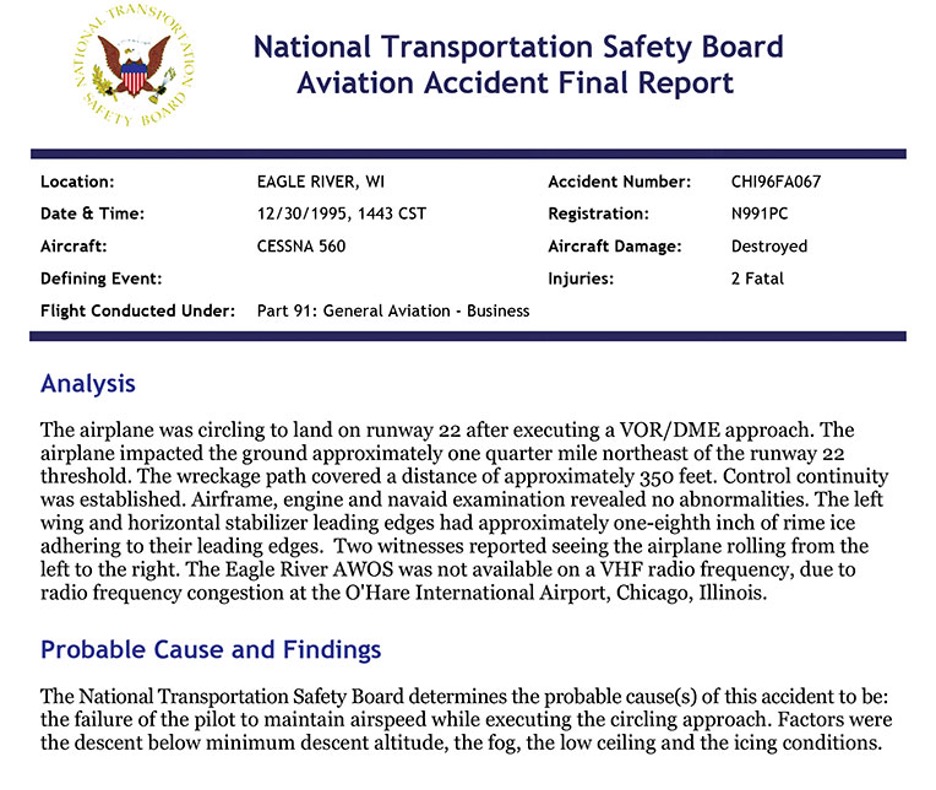Circle-to-Land Approaches
By Michael J. “Mick” Kaufman, CFII

I recently heard a story via the aviation telegraph of a pilot failing an instrument check ride with the FAA because of his refusal to do a circling approach. The flight was conducted in actual IMC conditions at night. It was the judgment of the pilot doing the check ride that this was not a safe maneuver under the conditions that prevailed at the time.
Several years ago, the FAA changed some of the circling criteria, and I researched the topic at that time. I personally avoid circle-to-land approaches whenever I can, especially in low IMC conditions and definitely at night. However, when conducting a BPT training program, part of the requirement for obtaining an IPC signoff is that we demonstrate a circling approach. When conducted as part of our program, it is done in VFR conditions during the day. There should be no safety concern.
So, under what circumstances would a pilot consider a circling approach, or when would ATC assign this approach?
- The runway that is aligned with the approach is closed for some reason, and there is not an approach for the landing runway.
- Wind conditions favor a circling approach.
- The pilot elects a circle-to-land approach due to time, distance or fuel to make the approach to the landing runway.
I will address each of the above-mentioned criteria.
Item 1. This is becoming less of an issue as we are getting more and more approaches using GPS. Prior to that, the position of the NAV-AIDs dictated which runways had published instrument approaches.
Item 2. This deals with a choice of landing with a tailwind, which again has become less of an issue as more runways have published IFR approaches. A study was conducted on landing a Bonanza or Baron with a tailwind, and it was found that a five-thousand-foot runway for a Bonanza and a six-thousand-foot runway for a Baron with a ten-knot tailwind component was sufficient. I stress that there is no room for error when doing a downwind landing using these numbers. I have tried it. If I had a choice of a straight-in approach with a tailwind or circling, I would elect the tailwind if weather conditions were low.
Item 3. This item goes to aeronautical decision making. If I were to approach an airport from the south and could line up for an approach to runway 1 with a circle-to-land on runway 19, would I do it? Assume the wind at the time was out of the south at twenty knots, and there is a good approach for runway 19, but I would need ten more minutes of flying time. My decision would now go to the weather conditions and the airport and any obstacles that might be a deterrent if I elected to circle. If it is apparent for some reason that I must circle on the approach, how will I accomplish this? I never go below circling minimums until absolutely necessary to make the landing. I remember a fatal airliner crash from several decades ago whereby an airliner got too low during a circling maneuver at night. The FAA immediately changed the procedure for circle-to-land maneuvers, and I believe that no airline pilot is allowed to make a circling approach (company policy) under these criteria. When I am doing a circling approach, I stay as high as I can until turning onto final approach. I use full flaps and minimum power with a steeper-than-normal approach. If the landing runway has a VASI or PAPI lighting system, I use it. To add to the stress of a circling approach, it is necessary to keep things in as tight to the airport as possible to avoid losing visual contact with the airport. At any time, if visual contact is lost with the airport, execute a go-around with a turn toward the airport.
Shortly after the FAA revised its circling criteria, I researched an accident that happened at one of my home airports where we have a summer home and hangar.
This accident involved a professional crew and it depicts a typical circling approach where, at the time of the accident, there was no other approach to runway 22. Stress was high, weather was bad, airspeed was slow, turn-in was tight and there was a bit of ice. Below is the NTSB report.

A month after I researched the topic of “circle-to-land” approaches and the circle-to-land accident at my home airport, I read of a similar accident involving a Lear 35 at Teterboro Airport, Teterboro, New Jersey (KTEB), which occurred on May 15, 2017.
This aircraft was on a circle-to-land approach. Below, I have included a few excerpts from the National Transportation Safety Board (NTSB) report; however, I urge you to read the entire NTSB Report #CEN17FA183, which is available on the Internet.
On May 15, 2017, at 1529 eastern daylight time, a Gates Learjet 35A, N452DA, operated by Trans-Pacific Jets, departed controlled flight while on a circling approach to Runway 1 at the Teterboro Airport (TEB), Teterboro, New Jersey, and impacted a commercial building and parking lot.
The New York Terminal Radar Approach Control (TRACON) cleared the flight for the TEB ILS Runway 6 Approach, circle to land Runway 1.
Upon reading the report, I think that many of us would call this a pilot error; however, we can go on and on reading reports of accidents involved in circle-to-land maneuvers. It puts the pilot in a tight situation with terrain / obstacles, slow airspeed, tight turns and the challenge of keeping the airport runway in sight.
I will discuss this topic more in future issues of BPT TAKEOFF and I hope to receive comments from our readers. Please send me an email at captmick@me.com with the subject line: Captain’s Corner.
Fly safely — and hope to see you at a BPT training program in the near future.



